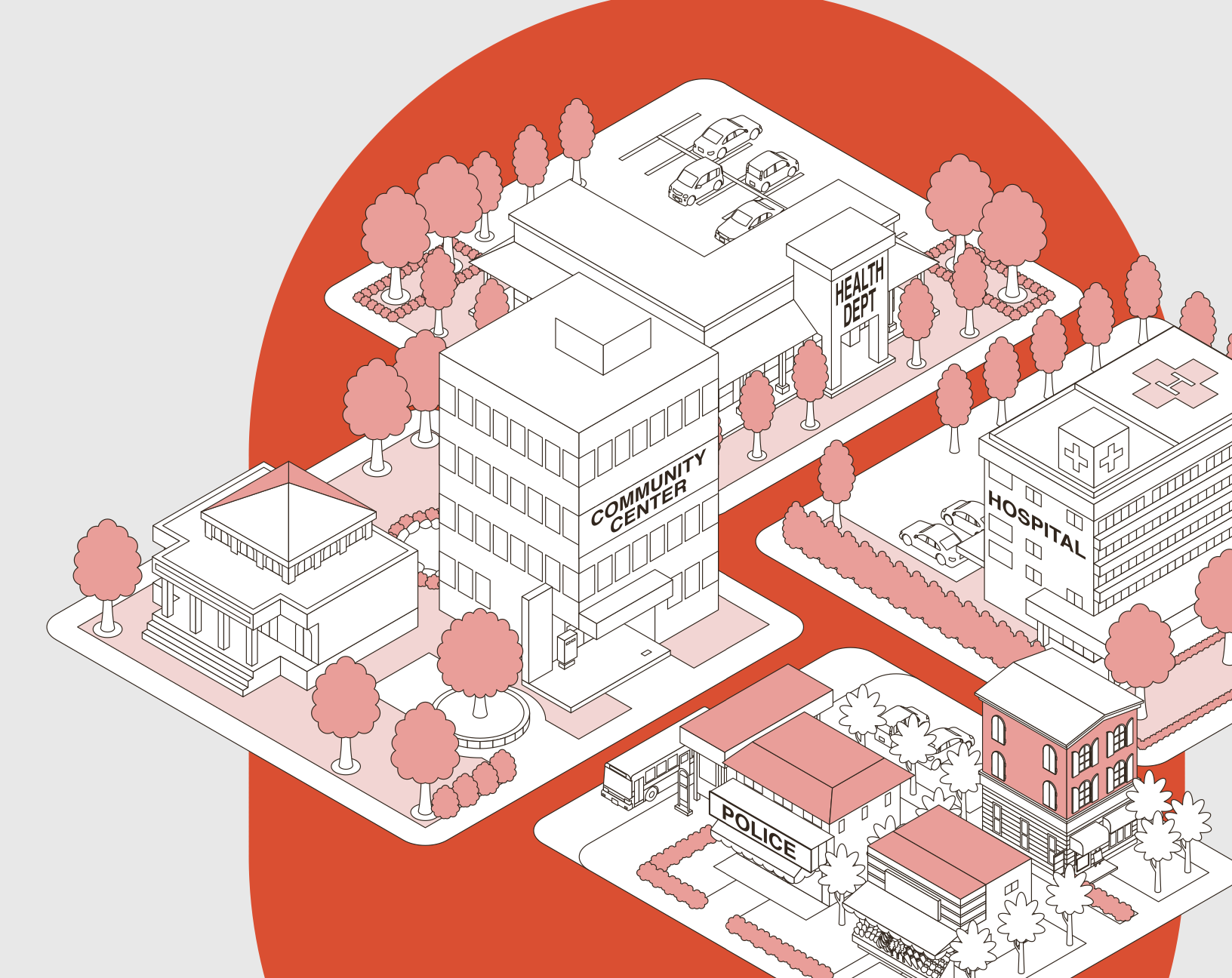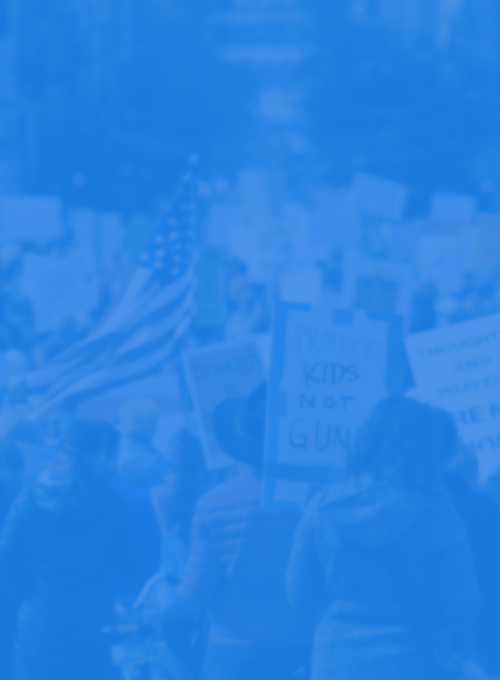
Community Violence Intervention
Community violence intervention (CVI) programs focus on individuals most at risk of being a victim of or committing an act of gun violence. CVI provides a public health approach to gun violence prevention, addressing the unique needs of the community where systemic racism, disinvestments, and trauma occur.
The Issue
Gun violence that occurs in public places – streets, parks, front porches-impacts the entire community. The trauma of community gun violence extends beyond those who are directly injured by a shooting to those in the community who are exposed as a witness, neighbor, classmate, or acquaintance. Gun violence exposure has lasting impacts on the physical and mental health and well-being of individuals and their communities. When individuals feel isolated, afraid to leave their homes, interact with neighbors, and participate in community functions, the health of the overall community is adversely impacted.
Community gun violence is concentrated in poor, segregated, and disinvested neighborhoods with few economic opportunities. These neighborhoods have suffered from a legacy of racist and discriminatory public policies which create the conditions for violence. Consequently, Black Americans are disproportionately impacted by community gun violence; they suffer from a gun homicide rate 14 times higher than their white peers.
A small number of people within these disinvested neighborhoods drive most of the violence. They are often caught in cycles of victimization, trauma, and retaliation, are disconnected from work and school, and lack the community supports to help them heal.
The Solutions
For generations, policing and incarceration have been the primary means to address gun violence in underserved communities and often these systems have been ineffective and perpetuated or exacerbated racial inequities. Community violence intervention programs are designed to reduce gun violence in the most impacted neighborhoods through outreach by credible messengers who work with individuals involved in gun violence. These programs are most effective when cities and states invest in comprehensive intervention and prevention efforts that engage a wide range of stakeholders and community leaders. A number of strategies are outlined below that work to identify individuals at highest risk for violence, leverage community support to change behaviors, and interrupt cycles of violence. Models employed locally should be data-driven and informed by the affected communities.
The Strategies
Violence Interrupter Programs (such as Cure Violence)
Credible members of the community are trained to interrupt cycles of retaliatory violence, help connect high risk individuals to social services, and change norms around using guns to solve conflict. Similarly, hospital-based violence intervention programs employ credible messengers to engage gun violence victims to discourage retaliation and connect them with social services that can potentially reduce risks for future violence.
Focused Deterrence
Also referred to as group violence intervention, this strategy creates a balanced partnership between law enforcement and community partners to identify chronic violent offenders and prevent them from engaging in future violence. Law enforcement advises these individuals of impending swift and certain legal action if violence continues. Community partners simultaneously offer social services and support to change risky behavior.
Cognitive Behavioral Interventions with Wraparound Supports
These programs focus on changing the life trajectory of an individual impacted by gun violence. Community-based practitioners and partners in the criminal justice system identify participants highly impacted by violence and provide cognitive behavioral interventions paired with wraparound social services, such as job placement, life coaching, and sometimes financial incentives to support them. Examples are READI Chicago, Roca, and Advance Peace.
Violence Reduction Councils / Homicide Review Commissions
Law enforcement, community members, criminal justice stakeholders, and service providers are brought together to analyze firearm violence within their city. Together, the council examines individual homicides and shootings to identify system gaps and missed opportunities for intervention. Through these case reviews the council develops policy recommendations to improve how the city both supports individuals at risk for violence and addresses the underlying risk factors for violence.
Changing Environmental Risk Factors for Violence
Beyond work to engage individuals at risk for violence, research shows that focusing on environmental factors which contribute to violence, such as large numbers of vacant buildings and blighted lots, a high density of alcohol outlets, and inadequate street lighting, can reduce gun violence in a community.
Violence Reduction Councils [VRC]

A new project led by co-director Cassandra Crifasi, PhD '14, MPH, associate professor, and Mallory O’Brien, PhD, associate scientist, with funding by the Bloomberg American Health Initiative at the Johns Hopkins Bloomberg School of Public Health will help empower communities to develop and implement Violence Reduction Councils through training and toolkits.
The Evidence
Violence Interrupter
The Center for Gun Violence Solutions partnered with the city of Baltimore to evaluate Safe Streets, a violence interrupter program. Findings from 2007-2022 support the hypothesis that Safe Streets Baltimore reduced homicides and nonfatal shootings over the many years the program operated in some of Baltimore’s most under-resourced neighborhoods. The average reductions ranged from 16% to 23% with larger reductions in homicides during the first four years of the longer running sites.1
Focused Deterrence
An analysis of 24 focused deterrence programs found that these strategies led to an overall statistically significant reduction in firearm violence. The most successful of these programs have reduced violent crime in cities by an average of 30% and improved relations between law enforcement officers and the neighborhoods they serve.2
Cognitive Behavioral Interventions with Wraparound Supports
Evaluations of programs that use cognitive behavioral interventions with wraparound supports like READI Chicago and Advance Peace show large reductions in arrests for violence and violent victimization of study participants.3,4 These promising early results indicate that identifying individuals at high risk and supporting them with job training and cognitive behavioral therapy can improve their safety, the safety of others, and promote economic opportunity.
Violence Reduction Councils / Homicide Review Commissions
The homicide review commission in Milwaukee was associated with a significant and sustained 52% reduction in homicides. A Department of Justice evaluation found shooting review boards to be an effective way to reduce gun violence by building trust between criminal justice stakeholders and the community.5 Homicide review commissions, also known as violence reduction councils, have strong potential to help cities bring together public safety, public health and community stakeholders to develop a comprehensive violence reduction strategy.
Changing Enviornmental Risk Factors for Violence
Funding for programs that clean and rehabilitate blighted and abandoned property are associated with both decreases in gun violence of up to 39% over one year and improved community health.6 These programs prevent gun violence by reducing the locations where illegal guns are stored and often where illegal activity linked to gun violence occurs. Likewise, these programs increase the connectedness between neighbors and strengthen the informal social controls that deter violence.
Community Violence Intervention
Community violence intervention (CVI) programs focus on individuals most at risk of being a victim of or committing an act of gun violence. CVI provides a public health approach to gun violence prevention, addressing the unique needs of the community where systemic racism, disinvestments, and trauma occur.
GO IN-DEPTH ON COMMUNITY GUN VIOLENCE
Our Work
The Center conducts applied research to reduce community gun violence through effective community violence intervention strategies. We use this research to advocate for and advance evidence-informed public health strategies. Center faculty and staff helped to establish offices of violence prevention in Colorado and North Carolina as well as to build state level infrastructure and funding for community violence intervention programs in New Mexico and Virginia.
Center staff and faculty continue to support the city of Baltimore's violence reduction strategies by evaluating Baltimore’s CVI programs and providing actionable recommendations to city agencies.
Core Center faculty created the homicide fatality review/violence reduction council model and they’ve helped multiple cities establish homicide review commissions/violence reduction councils. Most recently, Center faculty led a 2-year council in Hampton, Virginia, and they’ve convened stakeholders from eight cities to help them strengthen their review process.
Working with established community organizations, Center faculty and staff advocate for the implementation of policies, programs, and practices that invest in interventions that address risk factors for gun violence and break the cycle of violence in structurally disadvantaged communities.
Estimating the Effects of Safe Streets Baltimore on Gun Violence
Read more about how community violence intervention is working in Baltimore:

“Despite the deep challenges faced by communities that have experienced high rates of gun violence, research has shown that investments in targeted and well-implemented public health solutions can save lives and reduce trauma from gun violence. Continued research, engagement, and advocacy will spur future innovations and bring to scale effective solutions.”
Daniel Webster, ScD '91, MPH
Distinguished Scholar, Johns Hopkins Center for Gun Violence Solutions
The Center Resources
Journal Articles and Reports
- Webster DW, Tilchin CG, & Doucette ML. (2023). Estimating the Effects of Safe Streets Baltimore on Gun Violence. Johns Hopkins Center for Gun Violence Solutions. Johns Hopkins Bloomberg School of Public Health.
- South EC, Hemenway D, & Webster DW. (2022). Gun violence research is surging to inform solutions to a devastating public health crisis. Preventive Medicine.
- Crifasi CK, Williams RG, Booty MD, Owens-Young JL, Webster DW, & Buggs SAL. (2022). Community perspectives on gun violence and safety: The role of policing in Baltimore City. Journal of Criminal Justice.
- Ward JA, McGinty EE, Hudson T, Stone EM, Barry CL, Webster DW, Crifasi CK. (2022). Reimagining public safety: Public opinion on police reform and gun violence prevention by race and gun ownership in the United States. Preventive Medicine. https://www.sciencedirect.com/science/article/pii/S0091743522002298?via%3Dihub
- Webster DW, Richardson J, Meyerson N, Vil C, & Topazian R. (2022). Research on the effects of hospital-based violence intervention programs: Observations and recommendations. The ANNALS of the American Academy of Political and Social Science.
- Buggs SAL, Webster DW, & Crifasi CK. (2022). Using synthetic control methodology to estimate effects of a Cure Violence intervention in Baltimore, Maryland. Injury Prevention.
- Decker MR, Wilcox HC, Holliday CN, & Webster DW. An integrated public health approach to interpersonal violence and suicide prevention and response. (2018). Public Health Reports.
- Trangenstein PJ, Curriero FC, Webster D, Jennings JM, Latkin C, Eck R, & Jernigan DH. (2018). Outlet type, access to alcohol, and violent crime. Alcoholism: Clinical and Experimental Research.
- Milam AJ, Buggs S, Furr-Holden CD, Leaf P, Bradshaw CP, & Webster D. (2016). Changes in attitudes towards guns and shootings following implementation of the Baltimore Safe Streets Intervention. Journal of Urban Health.
- Whitehill JM, Webster DW, & Vernick JS. (2013). Street conflict mediation to prevent youth violence: Conflict characteristics and outcomes. Injury Prevention.
- Whitehill JM, Webster DW, Frattaroli S, & Parker EM. (2013). Interrupting violence: How the CeaseFire program prevents imminent gun violence through conflict mediation. Journal of Urban Health.
- Webster DW, Whitehill JM, Vernick JS, & Curriero FC. (2013). Effects of Baltimore’s Safe Streets Program on gun violence: A replication of Chicago’s CeaseFire program. Journal of Urban Health.
References
-
Webster DW, Tilchin CG, Doucette, ML. (2023). Estimating the Effects of Safe Streets Baltimore on Gun Violence.
-
Braga AA, Weisburd D, Turchan B. (2018) Focused deterrence strategies and crime control. Criminology & Public Policy.
-
Bocanegra E, Hoffman B. (2021). READI Chicago evaluation finds reductions in shootings and homicides. READI Chicago: A Heartland Alliance Program
-
Corburn J, Nidam Y, Fukutome-Lopez A. (2022). The art and science of urban gun violence reduction: evidence from the advance peace program in Sacramento, California. Urban Science.
-
Azrael D, Braga A, O’Brien M. (2013). Developing the capacity to understand and prevent homicide: an evaluation of the Milwaukee Homicide Review Commission. US Department of Justice.
-
Branas CC, Kondo MC, Murphy SM, South EC, Polsky D and MacDonald JM. (2016). Urban Blight remediation as a cost-beneficial solution to firearm violence. American Journal of Public Health.

